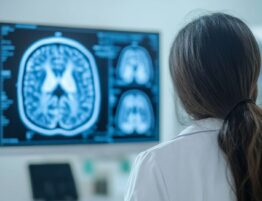Neurological disorders are increasingly common conditions affecting millions worldwide. These conditions range from mild symptoms to severe disabilities that significantly impact daily life. Individuals may experience tension headaches, epilepsy, Parkinson’s disease, or other neurological conditions that impair daily functioning and quality of life.
Early medical consultation helps address common neurological disorders before they become severe or irreversible. Modern diagnostic breakthroughs and automated testing technologies have significantly improved treatment outcomes. Healthcare providers help identify neurological symptoms and develop personalized treatment plans tailored to each individual’s needs. Recognizing early symptoms enables accurate diagnosis and customized care planning. Understanding specific diseases represents the first step toward choosing appropriate therapy and reducing anxiety through comprehensive health assessments.
Spotting Neurological Symptoms Early: When Warning Signs Signal Urgent Care
When individuals experience neurological problems, prompt medical treatment becomes essential for optimal outcomes. Professional medical teams offer personalized treatment approaches that consider each patient’s unique medical history. People seeking to improve their health can access specialized neurological care.
Early symptom recognition provides the foundation for timely intervention and successful treatment. The nervous system controls sensation, memory, movement, and cognitive function throughout the body. Minor changes in these functions can indicate serious diseases, making early detection crucial. Here are key neurological symptoms requiring immediate medical attention:
- Persistent Headaches. Symptoms often include headaches that persist for extended periods or worsen over time. Pain may intensify gradually or continue for several consecutive days without relief. Chronic headaches can be a sign of migraines, vascular problems, or other serious conditions.
- Numbness and Weakness. Neurological symptoms frequently include persistent numbness, tingling, or unexplained weakness. Individuals may experience loss of dexterity in their fingertips or a sudden reduction in strength. These sensations often indicate stroke, neuropathy, or other nerve-related disorders.
- Movement Disorders. Involuntary movements or tremors may be associated with Parkinson’s disease or movement disorders. These symptoms can develop suddenly and signal specific neurological complications requiring evaluation.
- Cognitive Changes. Individuals may experience memory problems, persistent confusion, or difficulty concentrating on tasks. Early stages of these symptoms often reflect dementia, cognitive impairment, or neurodegenerative processes. These symptoms frequently progress to severe disorders without proper intervention.
- Balance and Coordination Issues. Neurological symptoms include dizziness, balance problems, and coordination difficulties affecting daily activities. These problems may indicate multiple sclerosis, stroke, or other serious conditions. Patients may also experience changes in vision or speech difficulties, which may require examination.
Epilepsy Symptoms and Care: From Seizure Types to Safety and Treatment Basics
Epilepsy represents a serious neurological condition affecting millions of people worldwide. This disorder requires comprehensive study and management due to recurrent seizure episodes. Seizures result from abnormal electrical brain activity that characterizes this complex condition.
Healthcare providers study seizures across a broad spectrum to prescribe accurate treatments. Studying epilepsy symptoms enables doctors to conduct comprehensive patient evaluations and develop effective care plans. Medical teams collect necessary diagnostic data to prescribe personalized treatment approaches.
Here are key aspects of epilepsy symptoms and comprehensive patient care:
- Seizure Types. Various seizure types occur due to brain dysfunction, with focal seizures involving specific regions causing convulsions or consciousness changes.
- Common Triggers. Sleep deprivation, chronic stress, excessive alcohol consumption, and flashing lights frequently trigger seizure episodes in susceptible individuals.
- Safety Management. Patients should avoid dangerous situations when alone and create supportive environments to minimize seizure risks.
- Treatment. Electroencephalography (EEG) serves as the primary diagnostic tool while anticonvulsant medications control symptoms and reduce frequency.
Parkinson’s Disease Treatment Options: Medications, Therapies, and Lifestyle Support
Parkinson’s disease is a progressive neurological disorder primarily affecting brain areas controlling movement. This condition significantly impacts patients’ physical movements and manifests through various symptoms. While Parkinson disease treatment cannot be completely cured, consistent medical support is essential.
Treatment approaches continuously advance through technological innovations and improved therapeutic understanding. These developments enable patients to maintain optimal health and enhance their quality of life. Understanding the treatment options for Parkinson’s disease is essential for ensuring patient safety and comfort.
Parkinson’s disease causes significant long-term difficulties without proper medical intervention and care. However, modern treatment methods help relieve symptoms and provide comprehensive support. Effective management often requires medications, physical therapy, and sometimes surgical interventions.
Here are key treatment aspects encompassing comprehensive Parkinson’s disease management:
- Medication Management. Various drugs help reduce muscle stiffness, tremors, and movement difficulties.
- Physical Therapy. Comprehensive exercise programs enhance coordination, balance, and daily activity performance.
- Deep Brain Stimulation. Surgical option for severe cases not responding to medication alone.
- Lifestyle Support. Quality sleep, proper hydration, balanced nutrition, and stress reduction techniques help with Parkinson disease treatment.
- Family Support. Ongoing support helps reduce symptom impact and improve outcomes.
Our Diagnostic Approach: Confirming Common Neurological Disorders with Precision
Comprehensive diagnostic approaches enable the accurate and precise identification of common neurological disorders. Recognizing specific symptoms enables healthcare providers to prescribe personalized treatment plans that are tailored to each individual’s needs. Our methodology encompasses structured and thorough approaches designed to identify underlying causes.
Medical teams combine advanced innovative technologies with extensive clinical experience and expertise. Professional healthcare providers determine exact conditions and deliver adapted, personalized care to patients. Here are key diagnostic tools used for evaluating common neurological disorders:
- Advanced Imaging Studies. MRI and CT scans are utilized to detect common neurological disorders and brain abnormalities. These studies are extremely important for identifying changes in brain tissue and structures. Advanced imaging detects structural abnormalities, tumors, and pathological changes at early stages. MRI and CT technology help visualize damage caused by various neurological diseases.
- Electroencephalography (EEG). This diagnostic process measures continuous electrical activity throughout the brain during testing periods. Electroencephalography provides comprehensive approaches for detecting seizure disorders, epilepsy, and electrical brain abnormalities.
- Electromyography (EMG). This diagnostic tool evaluates muscle function and nerve conduction throughout the body. Electromyography examines peripheral nerves to detect neuropathies, myopathies, and neuromuscular disorders affecting function.
- Laboratory Testing. Common neurological disorders can be detected through specialized laboratory tests and analysis. Healthcare providers screen for infectious agents, autoimmune factors, and metabolic abnormalities contributing to symptoms.
- Differential Diagnosis. Comprehensive diagnostics enable healthcare providers to compare test results and systematically rule out potential conditions. This process excludes unlikely diagnoses while confirming appropriate conditions for future care.
Personalized Neurological Treatments: Tailored Care, Monitoring, and Long-Term Support
Understanding patient conditions and confirming accurate diagnoses requires comprehensive treatment planning and implementation. Treatment development should be specifically tailored to individual patient conditions and needs. Personalized care approaches help patients improve their quality of life and adapt to treatments.
Neurological treatments encompass holistic approaches designed to achieve optimal patient outcomes and success. Personalized treatment methods are essential for encouraging active patient participation in healthcare management. Integration of medication management, rehabilitative therapy, and technological assistance creates new possibilities.
Healthcare providers make evidence-based decisions using patient data and clinical expertise to achieve outcomes. Here are essential aspects of personalized neurological treatment:
- Medication Management. Healthcare providers prescribe appropriate medication dosages tailored to individual patient needs and conditions. Treatment involves constant adjustment and a combination of different medicines aimed at symptom improvement. Medical teams carefully control symptoms while minimizing potential side effects and interactions.
- Rehabilitation Programs. Neurological treatments utilize specialized rehabilitation programs designed to improve patient health and capacity. Physical therapy, speech therapy, and occupational therapy represent excellent therapeutic programs for patients. These programs support functional training and skill development while reducing the severity of symptoms.
- Digital Health Tools. Advanced digital tools help improve the accuracy of diagnoses and the effectiveness of treatments for patients. Specialized devices continuously monitor patient symptoms and transmit essential data to healthcare providers. Digital health technology helps maintain activity levels and supports medication adherence, leading to improved outcomes.
- Continuous Monitoring. Ongoing monitoring and clinical oversight are essential components of effective neurological treatment programs. Healthcare providers assess treatment effectiveness regularly and adjust approaches to reduce symptoms. Proper medical care ensures safe treatment protocols while maintaining optimal patient health and well-being.
How to Book and What to Expect: Step-by-Step Guide for Your Neurological Care Journey
Scheduling a neurological examination can be a comfortable and supportive experience for patients and their families. Making an appointment represents the first important step toward effective symptom management and treatment. Patients can make significant progress working collaboratively with professional healthcare teams and specialists.
Understanding the evaluation process helps patients feel relaxed, confident, and prepared for appointments. Here are significant steps involved in identifying neurological symptoms and beginning appropriate treatment:
- Appointment Scheduling. Patients can easily schedule appointments and visit specialized clinics for comprehensive evaluations. Healthcare providers help conduct thorough examinations and develop detailed plans for further testing and treatment.
- Preparation and Documentation. Patients should complete their preliminary paperwork and gather relevant medical history information before their appointments. Healthcare providers conduct comprehensive consultations, discuss concerning symptoms with patients, and review test results to provide personalized care. Preliminary preparation includes documenting symptom patterns, previous treatments, and current medications or therapies.
- Transparent Communication and Pricing. Complete transparency and strict confidentiality provide essential safeguards for all patients and their families. Reasonable insurance coverage and clear pricing information help patients understand their responsibilities. Patients know exactly what to expect and can manage their healthcare budgets appropriately.
Follow-up Care and Monitoring. After initial consultations, healthcare providers develop comprehensive diagnostic plans and closely monitor patient conditions. Medical teams utilize evidence-based neurological treatments to reduce symptoms and improve health outcomes. Patients can access ongoing support and begin prioritizing their health and well-being immediately.











Please, leave your review
Write a comment: